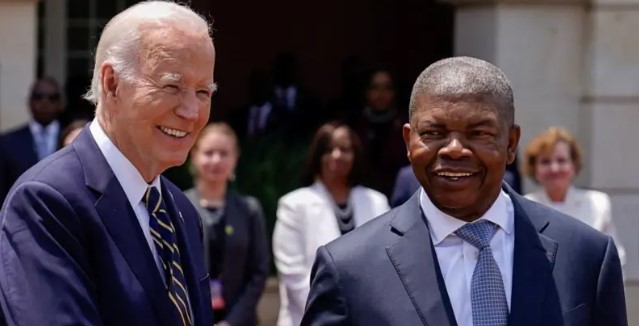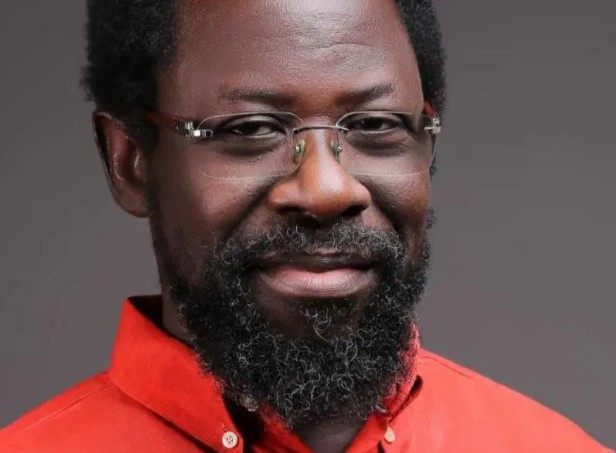
US President Joe Biden don say e dey “very proud to be di first American president to visit Angola” as im begin talks with im colleague João Lourenço.
Discussions for di presidential palace for di capital, Luanda, go be on security and trade.
US government dey back one new 1,300km (810-mile) railway project wey dey link one Angolan port with mining areas for neighbouring Democratic Republic of Congo and Zambia.
Di visit to di oil-rich Angola na part of a US effort to focus more on trade and investment for Africa, for wetin some analysts see as counter to China influence for di continent.
For im first and only trip to Africa during im presidency, Biden choice of Angola dey significant and e signal a dramatic improvement in relations between di two nations.
As e welcome di US president to di kontri, Lourenço bin describe di visit as a turning point in US-Angola relations.
“I dey deeply proud of everything we don do togeda to transform our partnership thus far,” Biden tok for response.
Angola dey firmly in di political orbit of China and Russia afta independence from Portuguese colonial rule in 1975, but since e take power for 2017, Lourenço don move am towards closer relations wit di US.
Later on Tuesday, Biden go visit one slavery museum. Dem bin forcibly send more dan four million slaves from dis region of Africa to di Americas.
“Togeda, di United States and Angola acknowledge di past horrors of slavery and im legacy, while looking forward to a bright future of continually deepening collaboration between our nations,” di White House bin tok for statement on Monday.
Significance of Biden visit to Angola
Joe Biden bin start im long-anticipated maiden visit to sub-Saharan Africa as US president but e dey come inside uncertainty over future US-Africa relations as Donald Trump dey prepare to succeed am for January.
Biden visit to oil-rich Angola follow attempt by America to focus more on trade and heavy investment in infrastructure, for wetin some analysts see as di most direct counter yet to China influence on di continent.
“Na perfect marriage of convenience,” Angolan analyst Edmilson Angelo bin tell di BBC.
Biden choice of Angola dey significant – e be di first US president to visit di kontri, e signal a dramatic improvement in relations between di two nations.
Angola bin firmly dey di political orbit of China and Russia afta independence from Portuguese colonial rule in 1975, but since taking power in 2017, President João Lourenço don move am towards closer relations wit di US.
“Lourenço administration don see Angolan foreign policy move away from ideology towards pragmatic multipolarity, to become truly non-aligned, “Alex Vines, director of di Africa programme for Chatham House, one London-based think thank tok.
Biden go highlight im signature initiative in di region – one railway line wey go stretch for 1,344km (835 miles), connect di cobalt, lithium and copper mines in di Democratic Republic of Congo, and di copper-belt region of Zambia, to di Angolan port city of Lobito on di Atlantic Ocean.
Apart from oil, Angola also dey rich in minerals, including cobalt and lithium, wey dey essential for making batteries for electric vehicles.
Once completed, di Lobito Corridor go help transport dis important minerals from di resource-rich heart of Africa across to Europe and di US.
On im website, di Lobito Corridor Investment Promotion Authority (IPA), say di US involvement “represent di first alternative from Washington DC to China Belt and Road Initiative” wey aim to build series of trade routes wey tie several countries in Africa, and elsewhere, to di Asian giant.
Biden visit dey come for di end of im presidency, wit no clarity yet on whether di Trump administration go continue wit di project.
Dr Vines believe say e “fit survive di Trump presidency as im primary aim na to compete against China”
However, e point out say both Western and Chinese firms go dey able to use di infrastructure, and dat “fit make im value questionable to Trump, a US president wey go likely define im administration in large measure by competition wit Beijing”.
Lourenço express hope say di Trump administration go build on di initiative.
“Powers come and go, so, all we need to do na to dey ready to work wit those wey go dey in power,” e bin tell di New York Times ahead of Biden visit.
Di Lobito Corridor na one joint project between di three African countries, di US, oda G7 powers and private investors.
“We get a collective commitment for global support among di G7 countries of $600bn [£470bn] and over – through 2027,” Helaina Matza, di acting special coordinator for di project for di US Department of State tok.
Lourenço bin defend di investment, dismiss concerns say dey mimic di colonial-era exploitation of Africa resources.
“Today, wen we export di minerals, we export dem in di interest of di African countries, different from wetin use to be in di colonial period wen dem bin dey extract dem without di consent of our indigenous pipo,” e bin tell di New York Times.
But more and more African kontries dey consider to reduce di export of raw materials to promote local processing.
Anthony Carroll, one minerals expert for di US Institute of Peace, tok say if dis happun, e go derail di projected economic impact of di corridor.
E dey optimistic say di vast deposits of copper in DR Congo and Zambia go keep di Lobito Corridor viable as “a steady demand” for am dey for existence globally.
Lithium and cobalt get more “cyclical” demand, e tok.
Di US Geological Survey estimate say DR Congo get nearly half of di world cobalt deposits.
Di central African country currently dey account for about 63% of di global supply of di mineral, most of which dem dey export raw.
Oga Angelo dey optimistic say African countries go slowly grow dia industrial capabilities.
E bin describe Biden visit, and di investment in di Lobito Corridor, as a big boost for Angola efforts to change im image.
“E bin present Angola as a safe place to invest,”Oga Angelo tok, e add say: “Wia di US president go, di whole world follow.”
Angola don dey rebuild im infrastructure following di end of one almost 30-year civil war for 2002.
Di conflict bin destroy di colonial-era Benguela railway line, wey be part of di corridor, wit only 3% of am in use for di end of di conflict.
Efforts to revive am den begin, wit China as di first to invest in am.
Between 2006 and 2014, China bin invest about $2bn to renovate di railway through one rail-for-oil deal.
But Lourenço don express regret over di deal, e bin tell di New York Times e dey “disadvantageous” to Angola.
“If you go ask me now if I go take a new loan under di same conditions, I go say: ‘No’,” e tok, e add say Angola go, nevertheless, pay off di debt.
China massive infrastructure investment, through im ambitious Belt and Road Initiative, don dey criticised for driving countries in Africa, and Asia, into deep debt.
Di US move into massive infrastructure investments in Africa go exist alongside Chinese-backed projects, to represent a more multipolar approach.
China already dey control up to 80% of copper mines in DR Congo, one of di world largest producers of di mineral.
Wit di global focus moving to greener energy, including electric vehicles, di mines of central Africa go become more and more attractive.
Di American shift to invest in infrastructure for di region dey come therefore as no surprise.
Already, work don start along di Lobito Corridor, wit di first phase of am wey include di upgrade of di existing railway from di port to DR Congo border, wit funding from di US Development Finance Corporation.
Ms Matza tok say di second phase go include 800km of new railway, wey go start for Angola.
Di goal na to eventually connect di Atlantic Ocean to di Indian Ocean through Tanzania.
Beyond transporting minerals, di railway fit also boost trade and agriculture across di route.
Di Africa Development Bank dey already fund projects to di tune of $500m to boost domestic and cross-border trade through di development of small businesses, cooperatives and traders along di Lobito Corridor.
For 2023, US trade wit Angola na approximately $1.77bn, according to di State Department, wey make di oil-producer America fourth-largest trade partner in sub-Saharan Africa.
President Biden visit dey fulfil one pledge wey e make to di continent in 2022, though e come late.
E also help to shape Angola place in regional and global development for years to come, despite uncertainties about wia di Trump administration go carry di relationship go.


